Towards a Trustworthy Rental Market: A Blockchain-Based Housing System Architecture
Abstract
1. Introduction
1.1. Research Background and Motivation
1.2. Research Objectives and Questions
- How can blockchain technology, specifically through decentralization, transparency, immutability, and smart contracts, be effectively applied to overcome the challenges in traditional rental markets?
- What is the optimal architecture for a blockchain-based rental system that integrates trusted third-party verification and Decentralized Identity (DID) to ensure the legitimacy of listings and protect user privacy?
- How can smart contracts be designed and implemented to automate rental processes, including rent payments, deposit handling, and lease termination, thereby increasing efficiency and fairness while reducing reliance on intermediaries?
- To what extent can the proposed blockchain-based system enhance privacy protection and improve identity verification for both landlords and tenants, fostering greater trust within the rental ecosystem?
1.3. Research Scope and Limitations
- Implementation Complexity: While a system model is proposed, a full-scale, nationwide deployment and its long-term societal impact are beyond the scope of this study.
- Regulatory Environment: This study acknowledges the current regulatory landscape, but a detailed analysis of potential legal or policy hurdles for blockchain adoption in real estate is not the primary focus.
- User Adoption: This research does not delve deeply into the socio-economic factors influencing user adoption rates of a new blockchain-based platform.
- Technological Evolution: The rapid evolution of blockchain and related technologies means that the proposed solutions may require adaptation in the future.
1.4. Research Methodology
- Problem Identification and Motivation: Detailed analysis of existing problems in the rental market, especially in Taiwan, including unverified listings, lack of transparency, weak contract protection, and data vulnerability, as outlined in Section 1.1.
- Objectives of a Solution: Defining the clear goals for the proposed system, such as enhancing security, transparency, and user empowerment.
- Design and Development: Proposing a novel rental platform architecture that integrates blockchain technology, Decentralized Identity (DID), and smart contracts. This includes conceptualizing the verifiable third-party mechanism.
- Demonstration: Illustrating the practical application of the proposed system through a detailed system model and, if feasible, a prototype implementation.
- Evaluation: Assessing the proposed system’s potential benefits in addressing the identified problems, focusing on aspects such as privacy protection, identity verification, automation, and cost reduction.
- Communication of Results: Presenting the findings, contributions, and implications for future research and development.
1.5. Research Contributions
1.6. Thesis Structure
2. Related Research
2.1. Fundamental Principles and Characteristics of Blockchain Technology
2.2. Applications of Blockchain Technology Across Diverse Fields
2.3. Blockchain Applications in Housing Rental Systems
2.4. Core Technologies and Concepts
2.4.1. Smart Contracts
2.4.2. Decentralized Identity (DID) and Self-Sovereign Identity (SSI)
2.4.3. Non-Fungible Tokens (NFTs)
2.4.4. Soulbound Tokens (SBTs)
2.4.5. InterPlanetary File System (IPFS)
2.4.6. Hyperledger Fabric
2.5. Research Gaps and Contribution of This Study
3. System Design and Architecture
3.1. Overall System Architecture
- Permissioned Blockchain Layer (Rental House Chain):
- Decentralized Identity Blockchain Layer:
- API and User Interface Layer:
- Trusted Third-Party Verification Authorities:
3.1.1. Decentralized Identity (DID) Chain
3.1.2. Rental House Blockchain
- A user generates a new cryptographic key pair specifically for interacting with the Hyperledger Fabric-based Rental House Chain.
- The private key for this chain is stored securely on the user’s local client (e.g., within their wallet) and is never exposed to the network.
- The user creates a Certificate Signing Request (CSR), which includes the public key of the newly generated key pair.
- This CSR is then submitted to the user’s PI contract on the DID-Chain. This action links their verified Decentralized Identity to their new account on the Rental House Chain.
- Blockchain Channels
- 2.
- Consortium Organizations
- 3.
- System Users
3.2. Smart Contract Design
3.2.1. Estate Register Contract
3.2.2. Estate Agent Contract
- A landowner initiates an entrustment request by invoking the AddEstate function, targeting a specific agent.
- The designated agent can then respond by calling either the AcceptEstate or RejectEstate function to approve or decline the request.
- The System Application can retrieve details of a specific delegation using the GetAgentEstate function or access all entrustment records for a particular agent via the GetAllAgentEstate function.
- AddEstate: Invoked by a landowner to submit an entrustment request to a designated real estate agent.
- AcceptEstate/RejectEstate: Invoked by the designated agent to approve or decline the pending entrustment request.
- The system also provides two query functions for retrieving these records:
- GetAgentEstate: Retrieves the details of a single, specific entrustment record.
- GetAllAgentEstate: Retrieves all entrustment records associated with a particular real estate agent.
3.2.3. Estate Publish Contract
- NewListing: Invoked by a landlord to publish a new rental listing, which sets its initial status to “Online”.
- ListingSigned: Called by the Rental Agreement contract upon the successful execution of a lease. This function updates the listing’s status, effectively removing it from the pool of available properties.
- GetAllOnlineListing: Retrieves all listings currently marked as “Online,” serving as the primary function for property discovery.
- GetListing: Retrieves detailed information for a single, specific listing.
- GetListingCondition: Retrieves any eligibility conditions or constraints associated with a specific listing.
- GetPersonListing: Retrieves all listings published by a specific landlord, identified by their public key.
3.2.4. Rental Agreement Contract
- The landlord submits the finalized agreement to the court’s off-chain system.
- The court invokes the CreateAgreement function, which records the agreementHashed and associated metadata on the blockchain.
- Both the landlord and the tenant then individually invoke the SignAgreement function to submit their digital signatures to the contract.
- Once both signatures are recorded, the VerifyAgreementSign function can be called to validate their authenticity.
3.2.5. Access Control Manager Contract
- UpdatePermission: Allows a user to grant or modify access rights for a specific data category to a designated verifier.
- RevokePermission: Allows a user to permanently revoke a previously granted access right.
3.3. Mapping of User Roles to Smart Contract Functions
3.4. Security Analysis
3.4.1. Resilience Against Distributed Denial-of-Service (DDoS) Attacks
3.4.2. Mitigation of Man-in-the-Middle (MitM) Attacks
- Cryptographic Integrity and Immutability: All transactions are secured using advanced cryptographic primitives, such as hash functions and digital signatures. The integrity of the ledger is maintained through a consensus mechanism that validates every block. This cryptographic linkage ensures that any unauthorized data tampering would be immediately detectable, as it would invalidate the hash of the tampered block and all subsequent blocks [3,6]. Once recorded, a transaction becomes a permanent and immutable part of the ledger, making retroactive alteration computationally infeasible.
- Offline Signing Mechanism: A cornerstone of our security design is the offline signing mechanism, which adheres to the principles of Self-Sovereign Identity (SSI) [10,16]. All transaction proposals are signed on the user’s local, secure client-side environment (e.g., their wallet). This critical design ensures that a user’s private keys are never exposed to the network or any server. Only the signed transaction, which is publicly verifiable but impossible to forge without the private key, is transmitted. This approach completely eliminates the risk of private keys being intercepted by a MitM attacker during network transmission, thereby guaranteeing transaction authenticity and non-repudiation.
- Immutable Agreement Fingerprints: To prevent tampering with Rental Agreements, the system records the cryptographic hash of each contract on the blockchain, creating a secure, immutable “digital fingerprint” [11]. Following this, the digital signatures of all contracting parties are also recorded on-chain. Any attempt by a MitM attacker to surreptitiously alter the agreement’s content after it has been signed would result in a hash mismatch, rendering the tampering attempt immediately obvious and futile. This method of ensuring data integrity by storing hashes on-chain is a common practice in blockchain applications, including those outside of real estate applications [9].
3.4.3. Mitigation of Spoofing and Impersonation Attacks
- Decentralized Identity (DID) System: Our DID solution, adapted from prior research [10], is central to user authentication. All participants must register using their official national identification numbers, which are verified off-chain by a government authority. The authority then records a cryptographic hash of the ID on the DID-Chain, creating a tamper-proof link between a real-world identity and a digital one. Since only the government authority can issue these Verifiable Credentials, this design effectively prevents malicious actors from creating fraudulent identities or impersonating legitimate users on the platform [6].
- Permissioned Blockchain Access Control: The use of Hyperledger Fabric provides an intrinsic layer of network security [15]. Its permission mechanism requires all participating nodes and users to be authenticated via a Certificate Authority (CA) and issued X. 509 certificates. This ensures that only pre-vetted trusted entities can join and transact on the network, fundamentally preventing unauthorized actors from gaining access to the core infrastructure.
- Dual Verification of Property and Identity: To prevent asset spoofing, all rental properties must undergo a dual-verification process. First, the Department of Land Administration (DLA) certifies property ownership. Second, the property owner’s identity is verified via the DID-Chain. Only after both verifications are successfully recorded on-chain is a property eligible for listing. This robust mechanism effectively eliminates the risk of fraudulent property listings and establishes a foundational layer of asset authenticity.
3.4.4. Resilience Against 51% Attacks
4. Workflow
4.1. Workflow Overview
- Property Registration: A landowner verifies and registers their property on the blockchain.
- Estate Agent Registration: A real estate agent verifies and registers their professional credentials.
- Property Entrustment: A landowner delegates management authority for a property to a registered agent.
- Rental Listing Publication: The landowner or their designated agent publishes a rental listing for the property.
- Property Search and Tenant Application: A prospective tenant searches for properties and submits a rental application.
- Rental Agreement Creation: The landowner drafts and proposes a formal Rental Agreement.
- Rental Agreement Execution: Both parties digitally sign the agreement, rendering it legally binding on the blockchain.
4.2. Property Registration and Verification
4.2.1. Off-Chain Ownership Verification by the DLA
- The landowner submits their national identification number and property address to the DLA’s off-chain system.
- The DLA queries its internal governmental registry to validate the authenticity of the ownership claim.
- Simultaneously, the DLA verifies the landowner’s identity. This is achieved by hashing the submitted ID number and comparing it against the corresponding hash stored on the DID-Chain. A match confirms that the identity claim is legitimate.
4.2.2. On-Chain Property Registration Within the System
4.3. Real Estate Agent Registration and Verification
4.3.1. Off-Chain License Verification by the DLA
4.3.2. On-Chain Credential Confirmation Within the System
4.4. Property Entrustment to a Real Estate Agent
4.4.1. Initiating the Entrustment Request
4.4.2. Agent Response and Finalization
4.5. Offline Signing Transaction Flow
- Transaction Proposal: The user, via the client application, initiates a transaction by submitting the required parameters for a specific smart contract function. The client application uses these parameters to construct a transaction proposal.
- Simulation and Endorsement: The client application sends this proposal to one or more designated endorsing peers in the network. Each peer simulates the transaction, verifies the client’s signature, and generates a proposal response (also known as an endorsement), which it signs with its own private key and returns to the client.
- Transaction Assembly: The client application collects the signed proposal responses from the endorsing peers. It verifies the peers’ signatures and ensures that the responses are consistent and satisfy the smart contract’s endorsement policy. The client then assembles these endorsements into a final transaction payload.
- Submission to Ordering Service: The client application submits the complete transaction payload (containing the original proposal and all endorsements) to the ordering service.
- Ordering and Block Creation: The ordering service sequences all received transactions into a cryptographically linked block. It does not inspect the transaction content but simply establishes a definitive order.
- Validation and Ledger Commit: The ordering service broadcasts the newly created block to all committing peers in the network. Each peer independently validates every transaction within the block, checking for endorsement policy fulfillment and ensuring there are no state conflicts.
- Ledger Update: Upon successful validation, each committing peer appends the block to its local copy of the ledger, and the world state is updated accordingly. The client application is then notified of the transaction’s successful commitment.
4.6. Rental Listing Publication
- The verified property owner, as confirmed by the Estate Register contract.
- A certified real estate agent who has been officially entrusted with management rights for that specific property, as recorded in the Estate Agent contract.
4.7. Property Search and Tenant Application
4.7.1. Property Search and Expression of Interest
- Property Discovery: When a landlord publishes a rental listing, its status is set to “Online.” Prospective tenants can then access a comprehensive list of all active listings via the System Application. The application calls the GetAllOnlineListing function to retrieve this data directly from the blockchain, ensuring that all displayed listings are current and verifiable on-chain.
- Detailed Review: If a tenant is interested in a particular listing, they can request its detailed information. By providing the landlord’s and the property’s addresses, the System Application retrieves the full listing details, including rental terms, conditions, and any specific eligibility requirements set by the landlord.
- Application Submission: After reviewing the details, the tenant can submit a formal expression of interest (i.e., a rental application) through the application. This action notifies the landlord of the tenant’s interest and initiates the subsequent stages of the rental process.
4.7.2. Privacy-Preserving Qualification Review
- Tenant Consent: To enable this feature, the tenant must first grant consent. Using the Offline Sign mechanism, the tenant signs a transaction that authorizes the NTB to perform specific data checks on their behalf. This creates a verifiable, on-chain proof of consent.
- Landlord Request: After receiving a rental application, the landlord can issue a qualification review request to the NTB. Before proceeding, the NTB verifies that the tenant has granted the necessary permissions and immutably logs with respect to the landlord’s request on the blockchain, creating a tamper-proof audit trail.
- Off-Chain Verification: The NTB then retrieves the eligibility criteria from the on-chain rental listing by using the GetListingRestriction function. It cross-references these criteria with the tenant’s confidential off-chain data (e.g., income records).
- Result Attestation: Based on this comparison, the NTB returns a simple, binary attestation to the landlord: “pass,” “fail,” or “permission denied.” Crucially, no raw personal data (e.g., actual income figures) is ever disclosed to the landlord.
4.8. Rental Agreement Creation and Execution
4.8.1. Rental Agreement Creation and On-Chain Registration
- Authorization Check: Before proceeding, the system performs a critical authorization check. If the party creating the contract is an entrusted real estate agent, the system verifies that their entrustment agreement grants them the authority to sign on behalf of the landowner.
- Off-Chain Storage: The landlord (or authorized agent) drafts the complete Rental Agreement and submits it to the court’s secure off-chain database. This ensures the confidentiality of the full contract text.
- On-Chain Fingerprinting: The court system then generates a cryptographic hash of the agreement (agreementHashed), which serves as its unique, immutable “digital fingerprint.” The court invokes the CreateAgreement function to record this hash and other essential metadata on the blockchain, placing the agreement into a “pending signature” state.
4.8.2. Digital Signature Execution and Contract Activation
- Signature Generation (Offline): The landlord and tenant are prompted by the System Application to sign the agreementHashed value. Each party uses a locally stored private key to generate a unique digital signature. This cryptographic operation is performed entirely within the user’s secure client environment, ensuring that their private key is never exposed.
- Signature Submission: Each party then invokes the SignAgreement function to submit their respective digital signature to the Rental Agreement smart contract.
- Verification and Activation: Once all signatures are submitted, a final verification step is initiated. This action activates the VerifyAgreementSign function, which performs on-chain verifications to validate each signature against the agreementHashed using the corresponding public keys.
- Finalization and Status Update: Upon successful verification of all signatures, the VerifyAgreementSign function executes two critical actions:
- It updates the Rental Agreement’s status to “Active,” marking it as fully executed and legally binding.
- It triggers a cross-contract call to the Estate Publish contract to update the property listing’s status to “Signed,” thereby removing it from the public marketplace.
5. Experimental Evaluations
5.1. Analysis of the Proposed Solution
- Unverified Property Listings
- 2.
- Lack of Market Transparency
- 3.
- Inadequate Lease Protection
- 4.
- Personal Data Vulnerabilities
5.2. Experimental Evaluation
5.2.1. Experimental Environment and Methodology
5.2.2. Performance of the Estate Register Contract
5.2.3. Performance of the Estate Agent Contract
5.2.4. Performance of the Estate Publish Contract
- Caching: This strategy involves temporarily storing frequently accessed data on the application layer, thereby minimizing direct queries to the blockchain for repeated searches. This approach can significantly reduce response times by serving requests from a faster local cache.
- Paginated Access: This method limits the number of records returned in a single query. By employing bookmarks to track the last accessed item, the system enables efficient navigation through large datasets without overwhelming the user or the backend infrastructure.
5.2.5. Performance of the Rental Agreement Contract
5.2.6. Performance of the Access Control Manager Contract
5.2.7. Experimental Conclusion
5.3. Related Research Comparison
6. Conclusions and Future Research
6.1. Conclusions
6.2. Future Research
Author Contributions
Funding
Data Availability Statement
Conflicts of Interest
References
- Department of Statistics. Week 46, 2024 Ministry of the Interior Statistical Bulletin (As of the End of 2023, the Ministry of the Interior Had Received 687,000 Lease Contracts, an Increase of 279,000 or +68.4% Compared to the End of 2022); Ministry of the Interior, Republic of China: Taipei, Taiwan, 2024. Available online: https://www.moi.gov.tw/News_Content.aspx?n=9&s=323082 (accessed on 27 November 2024).
- Department of Population Census; Directorate-General of Budget; Accounting and Statistics; Executive Yuan; R.O.C. (Taiwan). Statistical Information Network of the Republic of China—Population and Housing Census; Statistical Information Network of the Republic of China: Taipei, Taiwan, 2024. Available online: https://www.stat.gov.tw/cl.aspx?n=2748 (accessed on 27 November 2024).
- Wang, C.; Jia, W.; Chen, Y. Housing Rental Scheme Based on Redactable Blockchain. Wirel. Commun. Mob. Comput. 2022, 2022, 1137130. [Google Scholar] [CrossRef]
- Sharma, S.; Kumar, A.; Sengar, N.; Kaushik, A.K. Implementation of Property Rental Website Using Blockchain with Soulbound Tokens for Reputation and Review System. In Proceedings of the 2023 Securing Next Generation Systems Using Future Artificial Intelligence Technologies (SNSFAIT), New Delhi, India, 25 May 2023; IEEE: Jaipur, India, 2023; pp. 27–36. Available online: https://ceur-ws.org/Vol-3390/Paper3.pdf (accessed on 27 November 2024).
- Jain, A.; Gangwar, A.; Kumari, C.; Mehra, P.S. A Survey on Blockchain for Rental Lease Management. In Proceedings of the 2024 11th International Conference on Reliability, Infocom Technologies and Optimization (Trends and Future Directions) (ICRITO), Noida, India, 14–15 March 2024; pp. 1–5. [Google Scholar] [CrossRef]
- Yu, R.; Wang, Z.; Zhang, C.; Guan, S. A Secure Blockchain-Based Housing Rental Platform. In Proceedings of the 2021 IEEE 4th Advanced Information Management, Communicates, Electronic and Automation Control Conference (IMCEC), Chongqing, China, 18–20 June 2021; Volume 4, pp. 2049–2053. [Google Scholar] [CrossRef]
- Junaid, L.; Bilal, K.; Shuja, J.; Balogun, A.O.; Rodrigues, J.J.P.C. Blockchain-Enabled Framework for Transparent Land Lease and Mortgage Management. IEEE Access 2024, 12, 54005–54018. [Google Scholar] [CrossRef]
- Nakamoto, S. Bitcoin: A Peer-to-Peer Electronic Cash System. 2009. Available online: https://bitcoin.org/bitcoin.pdf (accessed on 27 November 2024).
- Casado-Vara, R.; Prieto, J.; Corchado, J.M.; de la Prieta, F. A Food Traceability System Based on Blockchain and Radio Frequency Identification Technologies. J. Comput. Commun. 2020, 8, 17–27. [Google Scholar] [CrossRef]
- Hsieh, Y.H.; Guan, X.Q.; Liao, C.H.; Yuan, S.M. Physiological-chain: A Privacy Preserving Physiological Data Sharing Ecosystem. Inf. Process. Manag. 2024, 61, 103761. [Google Scholar] [CrossRef]
- Santos, J.F.; Correia, M.P.; Dias, T.R. Blockchain-Based Rental Documentation Management with Audit Support. In Proceedings of the 2024 6th Conference on Blockchain Research & Applications for Innovative Networks and Services (BRAINS), Paris, France, 9–11 October 2024; pp. 1–10. [Google Scholar] [CrossRef]
- Qi-Long, C.; Rong-Hua, Y.; Fei-Long, L. A Blockchain-based Housing Rental System. In Proceedings of the International Conference on Advances in Computer Technology, Information Science and Communications, Xiamen, China, 15–17 March 2019; pp. 15–17. [Google Scholar] [CrossRef]
- Xue, Q.; Hou, Z.; Ma, H.; Zhu, H.; Ju, X.; Sun, Y. Housing Rental System Based on Blockchain Technology. J. Phys. Conf. Ser. 2021, 1948, 012058. [Google Scholar] [CrossRef]
- European Union. Regulation (EU) 2016/679 of the European Parliament and of the Council of 27 April 2016 on the protection of natural persons with regard to the processing of personal data and on the free movement of such data (General Data Protection Regulation). Off. J. Eur. Union 2016, 119, 1–88. [Google Scholar]
- Androulaki, E.; Barger, A.; Bortnikov, V.; Cachin, C.; Christidis, K.; De Caro, A.; Enyeart, D.; Ferris, C.; Laventman, G.; Manevich, Y.; et al. Hyperledger Fabric: A Distributed Operating System for Permissioned Blockchains. Proc. Thirteen. EuroSys Conf. 2018, 30, 1–15. [Google Scholar] [CrossRef]
- Preukschat, A.; Reed, D. Self-Sovereign Identity; Manning Publications: Shelter Island, NY, USA, 2021. [Google Scholar]
- Chen, J.-H. A Study on Recent Efforts by the Central Government of the Republic of China to Improve Real Estate Market Regulations: A Case Study of the Ministry of the Interior; Legislative Yuan, Republic of China: Taipei, Taiwan, 2024. Available online: https://www.ly.gov.tw/Pages/List.aspx?nodeid=45658 (accessed on 27 November 2024).
- Hyperledger-Labs. GitHub–Hyperledger/Fabric-Samples: Samples for Hyperledger Fabric. Available online: https://github.com/hyperledger-labs/fablo (accessed on 27 November 2024).
- Apache Software Foundation. Apache JMeter–Apache JMeterTM. Available online: https://jmeter.apache.org/ (accessed on 27 November 2024).
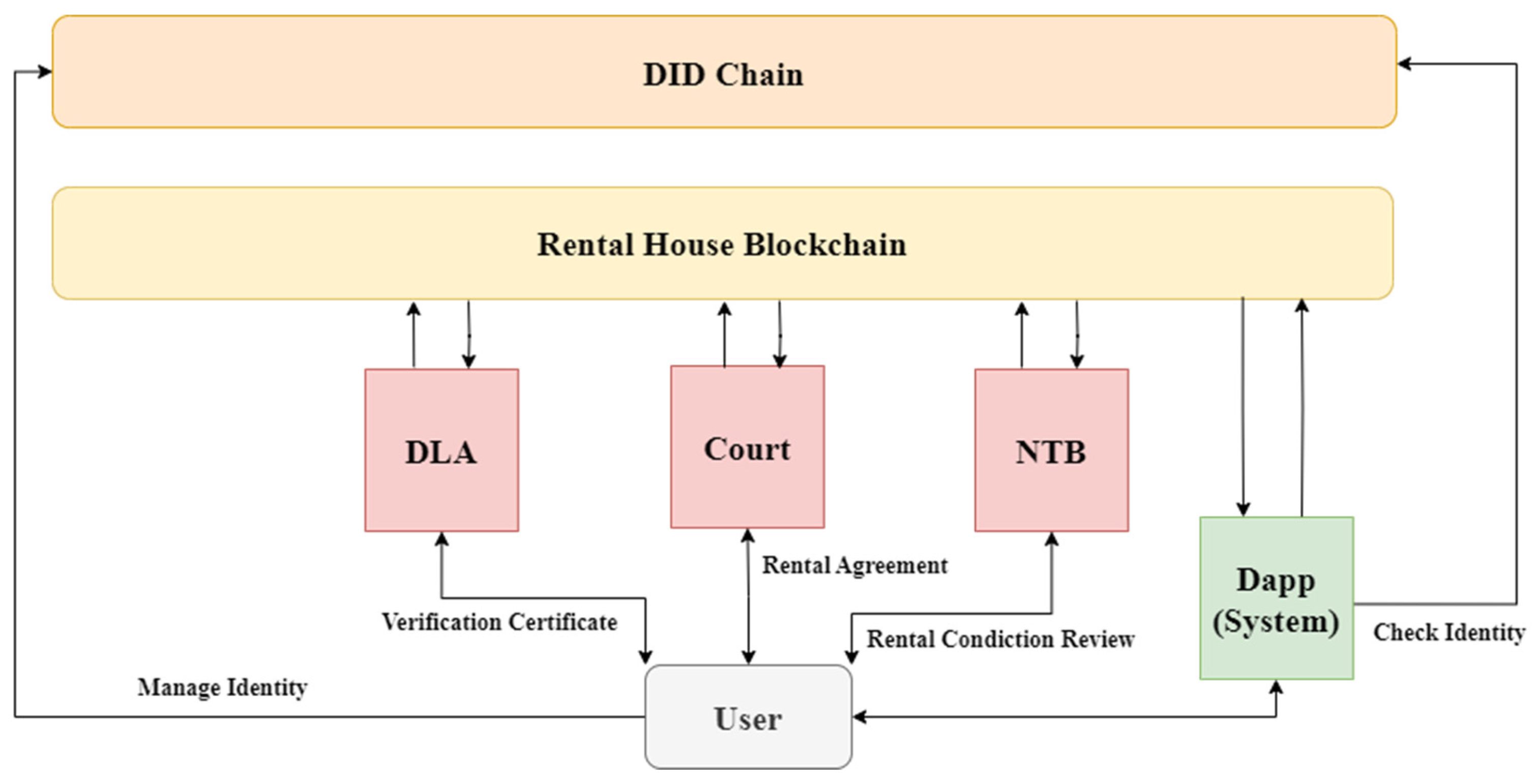
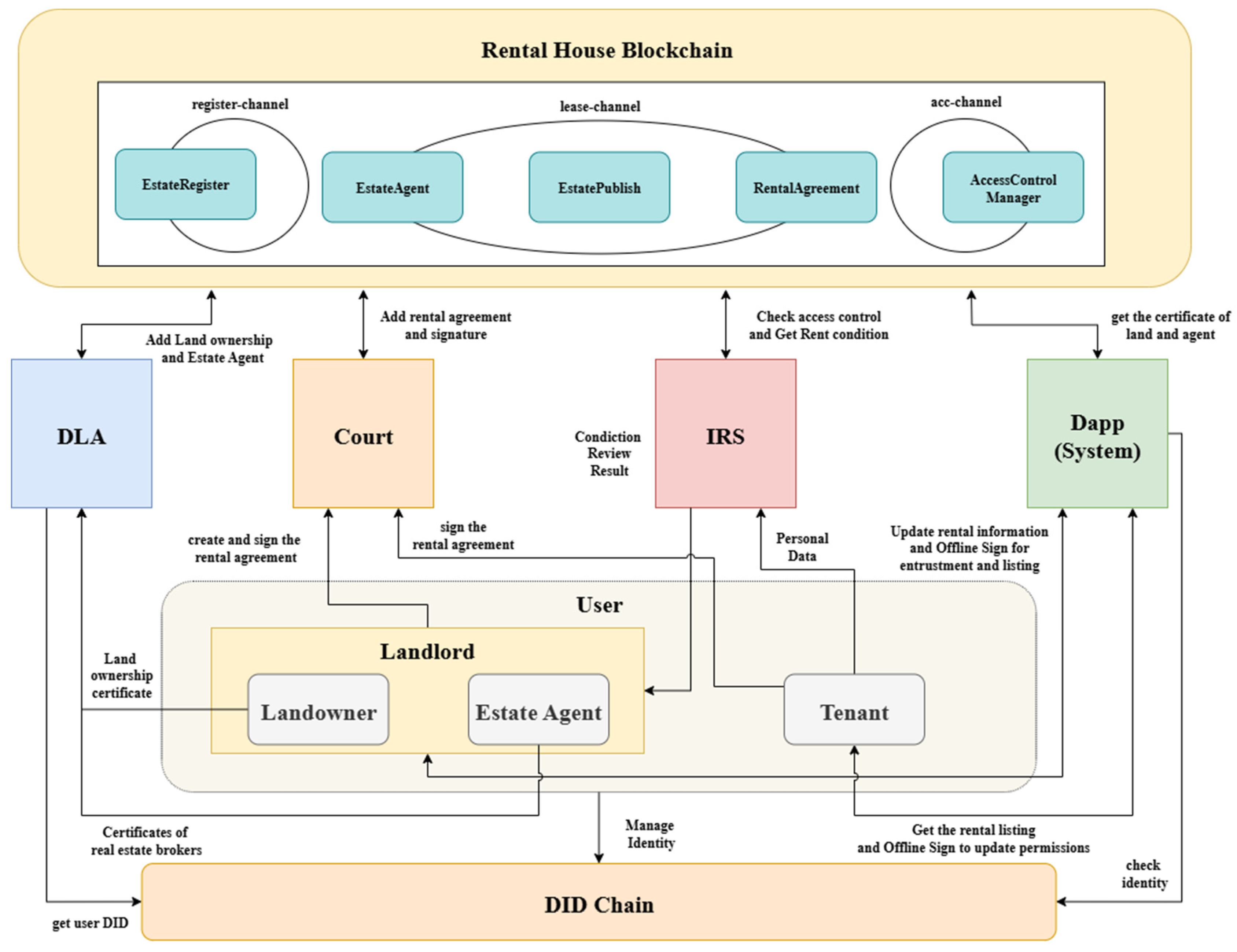

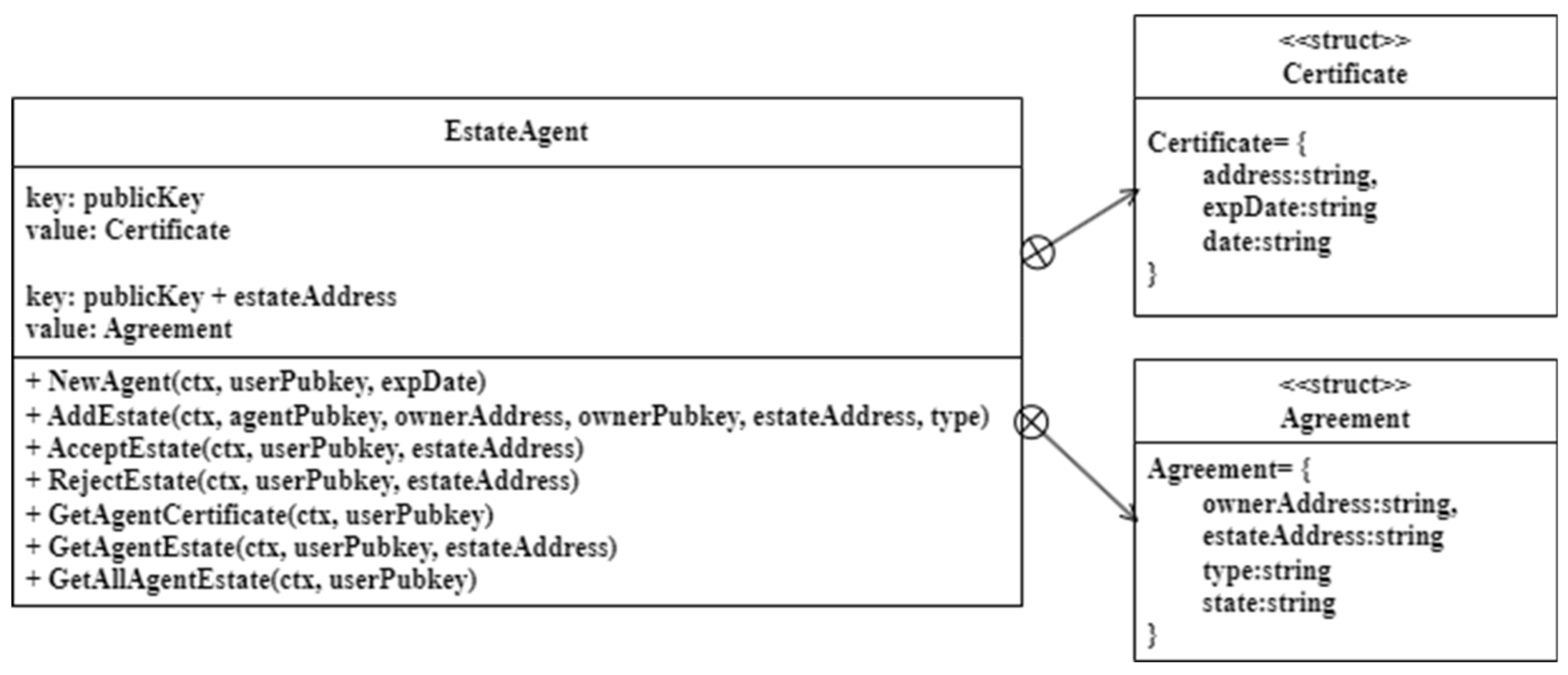






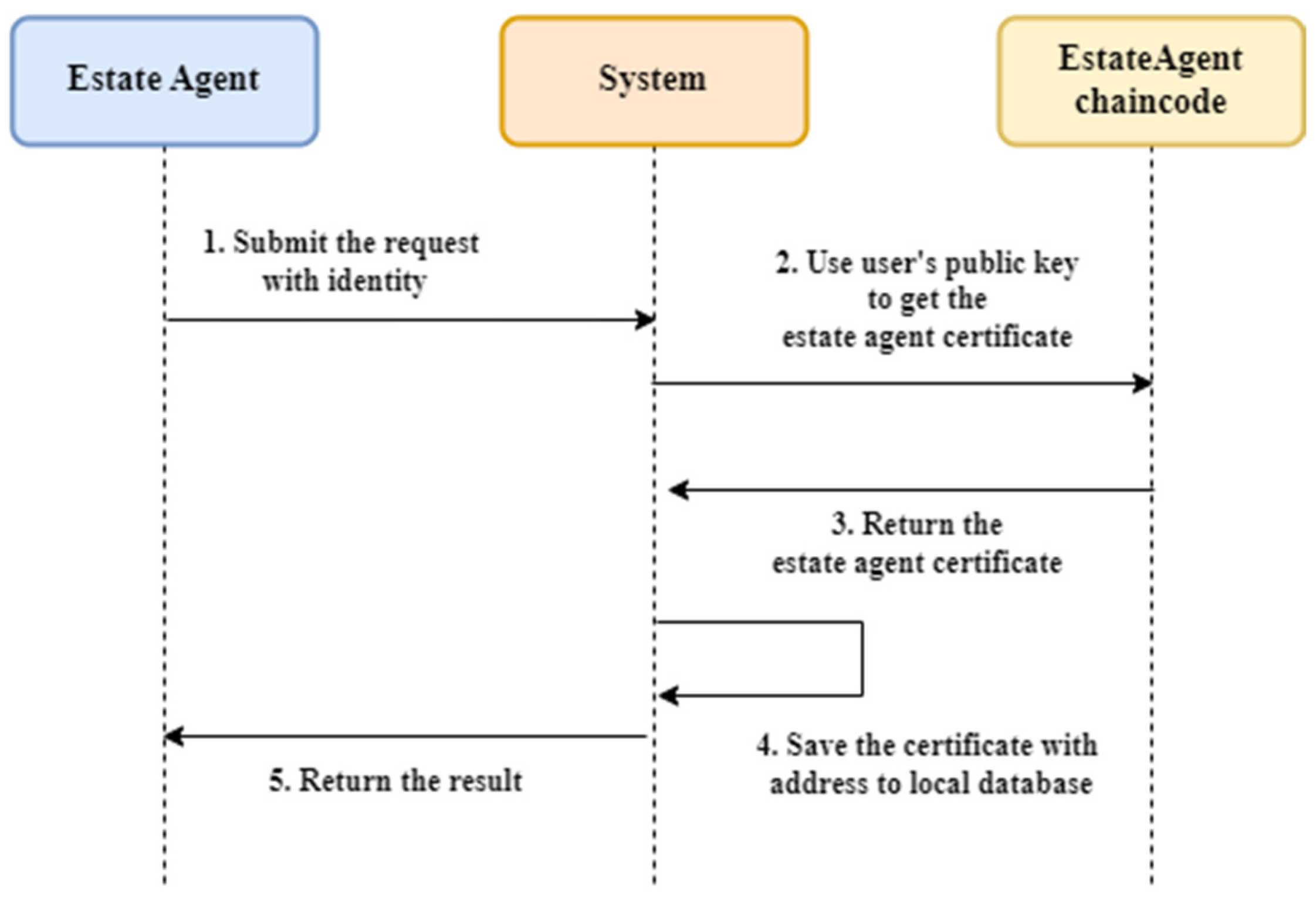

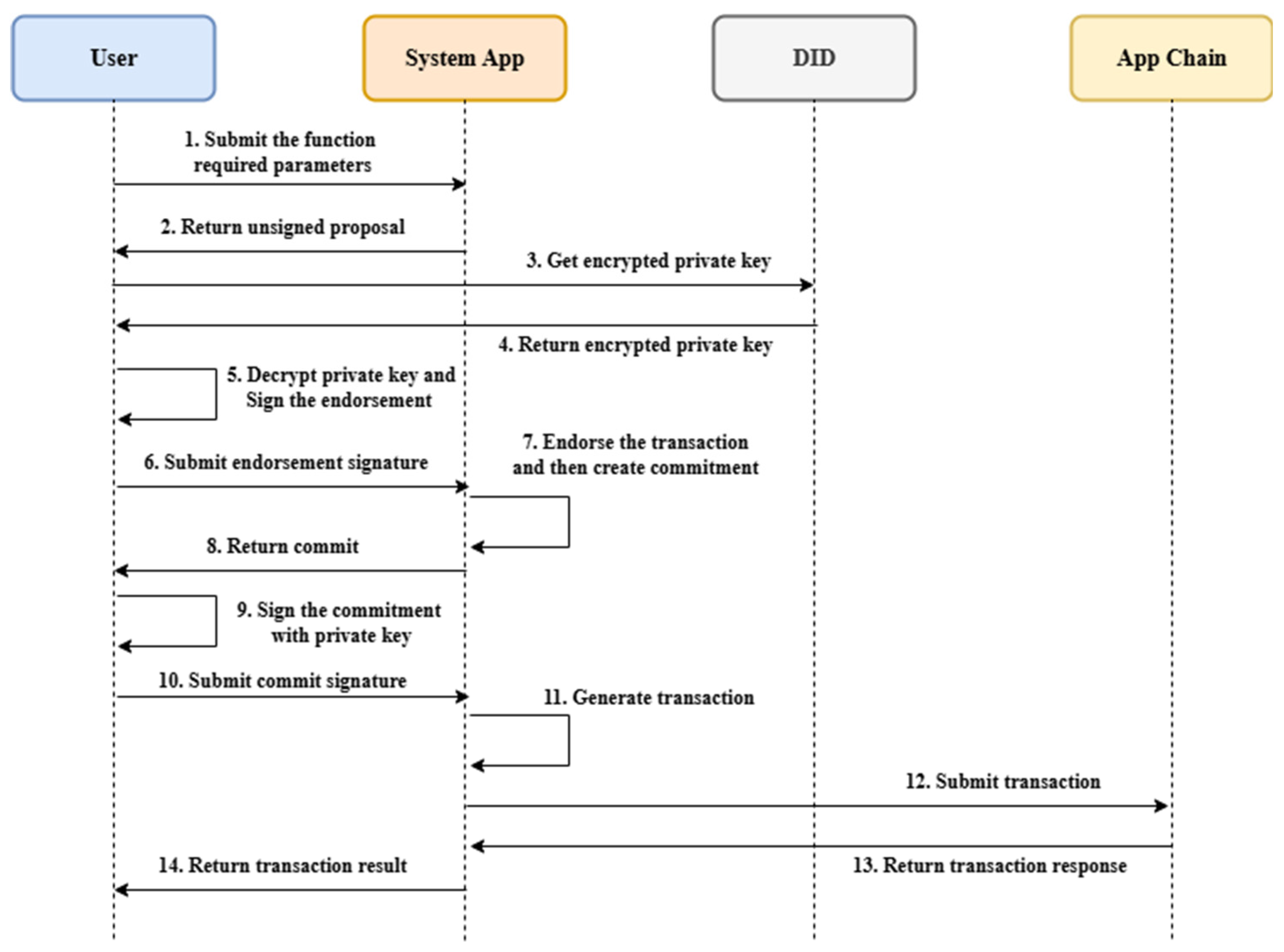

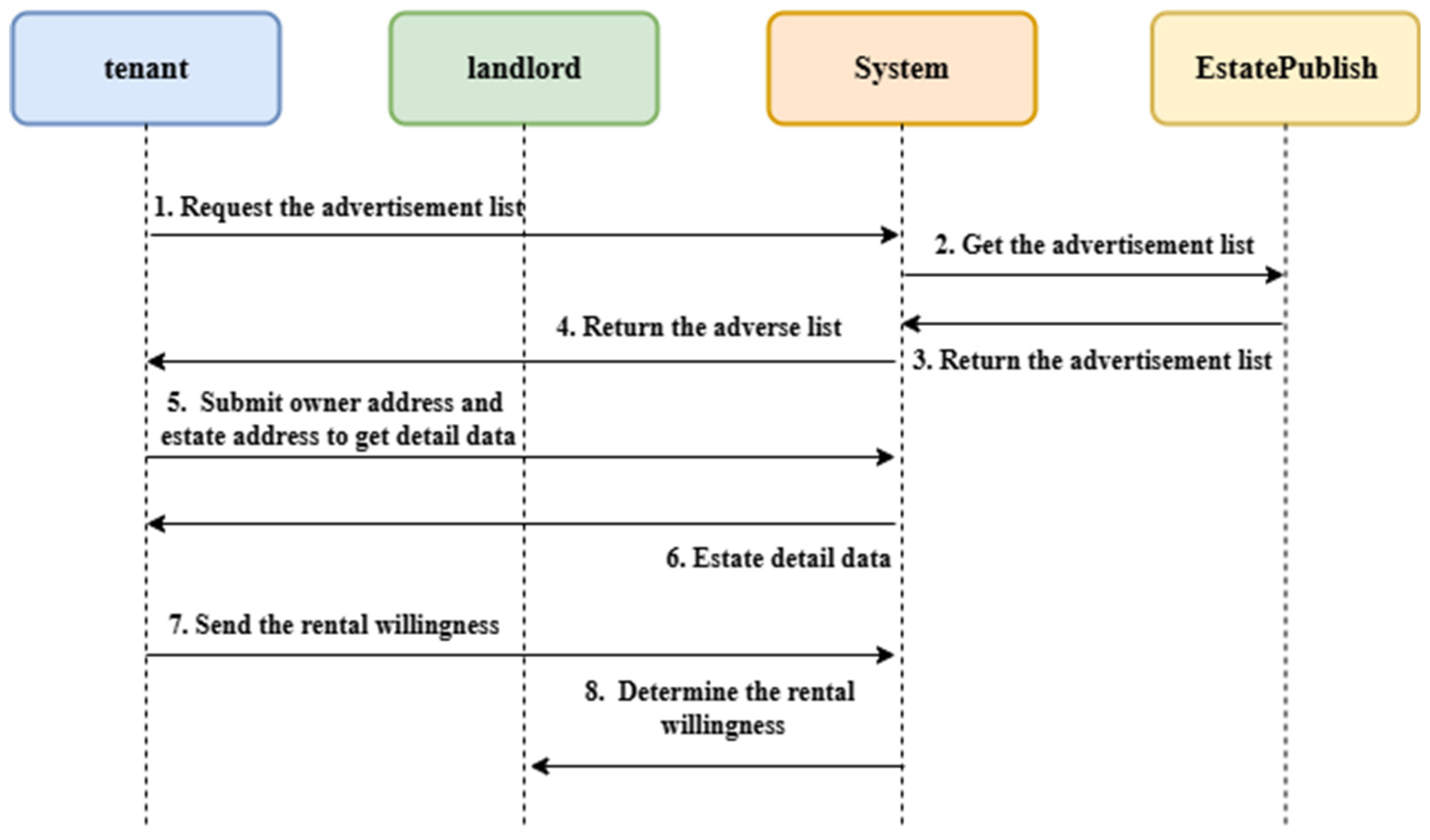


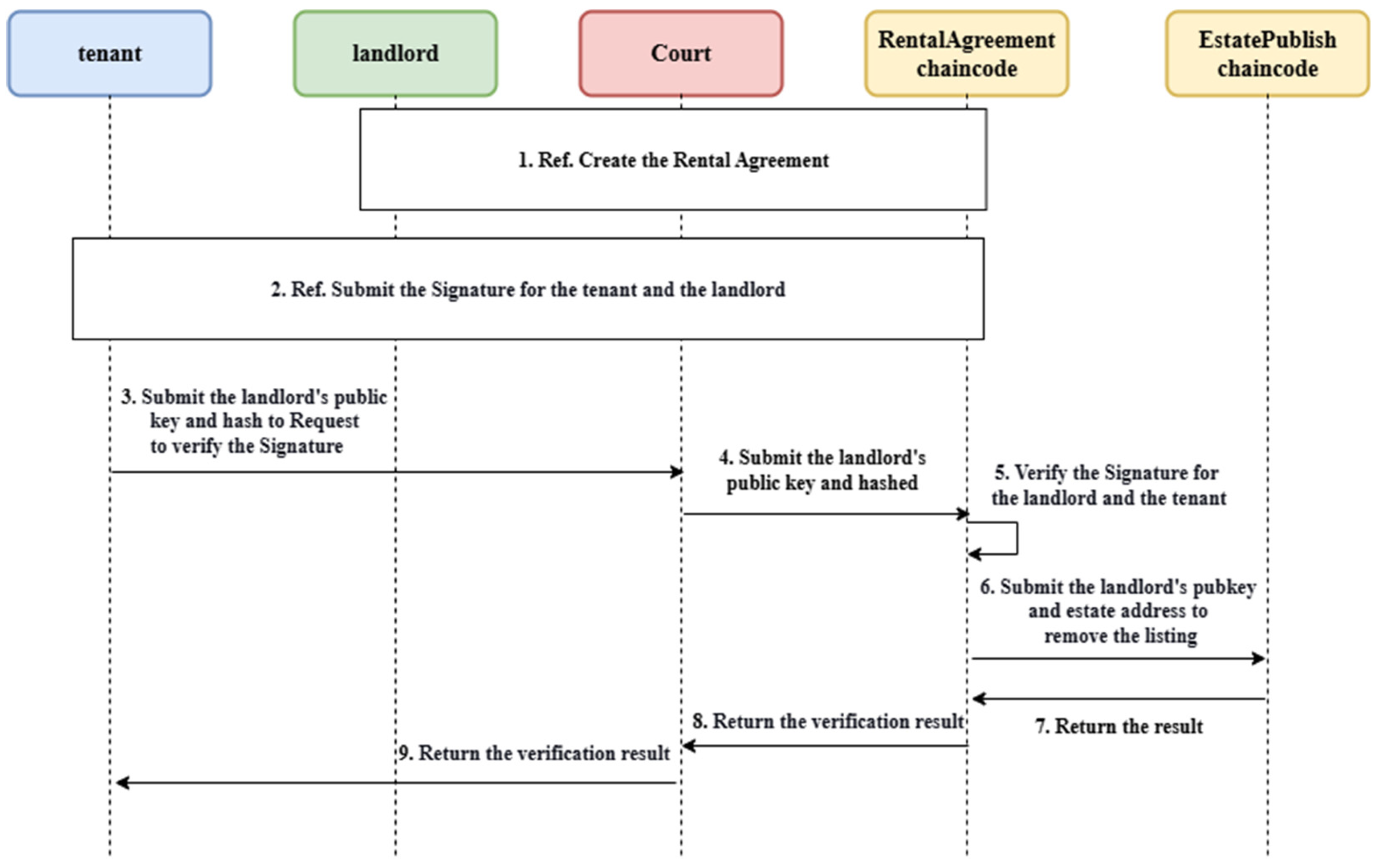

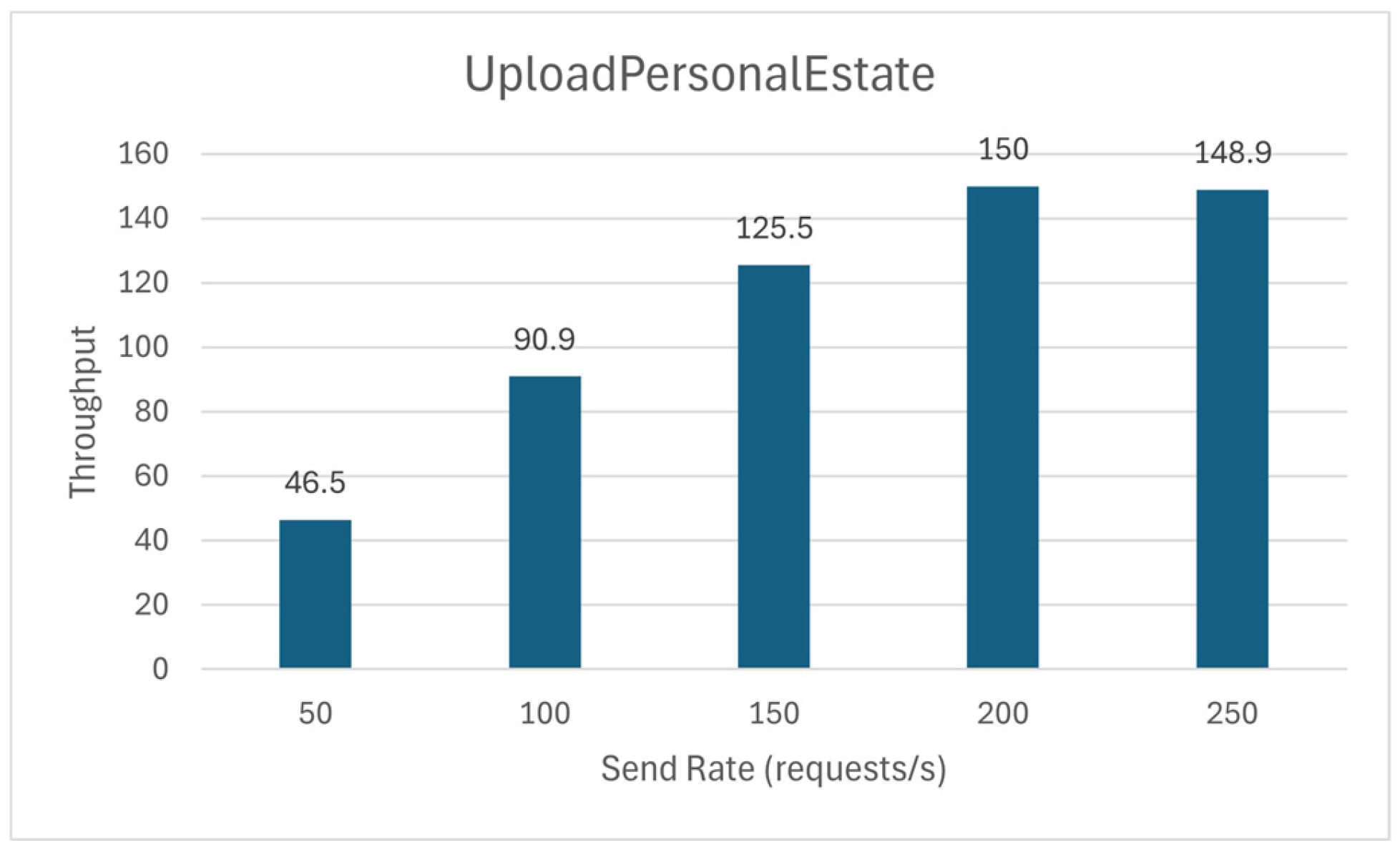
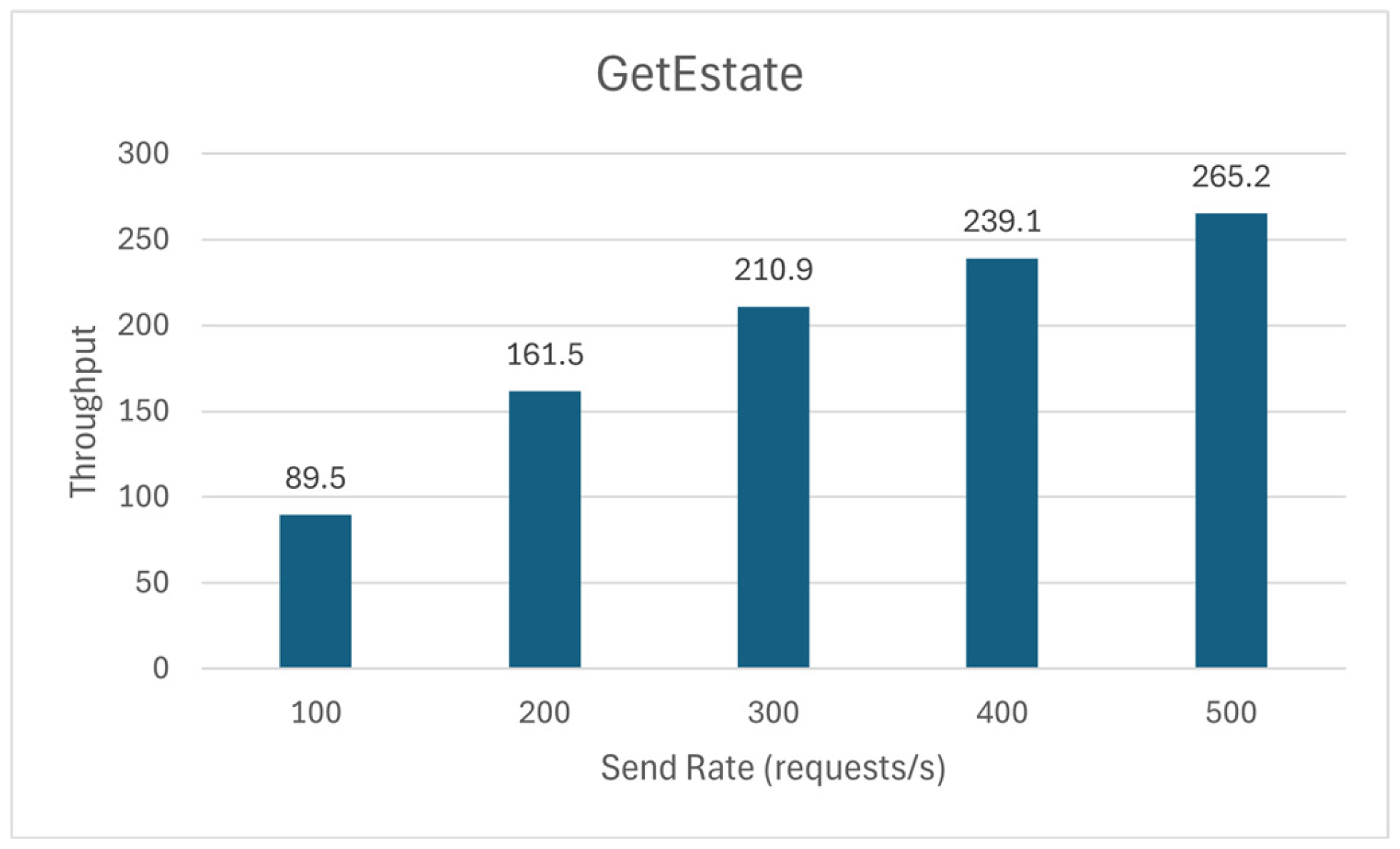
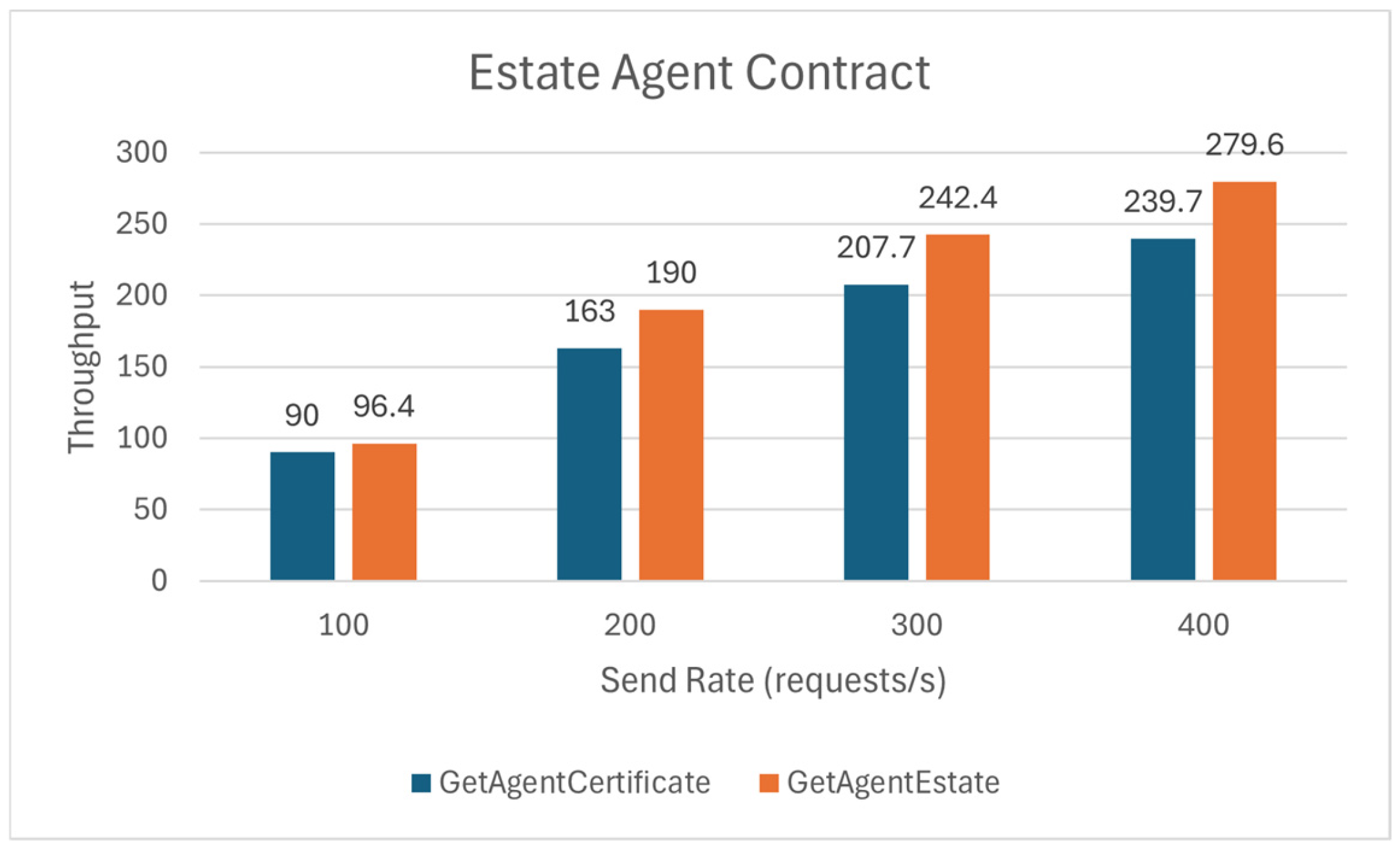
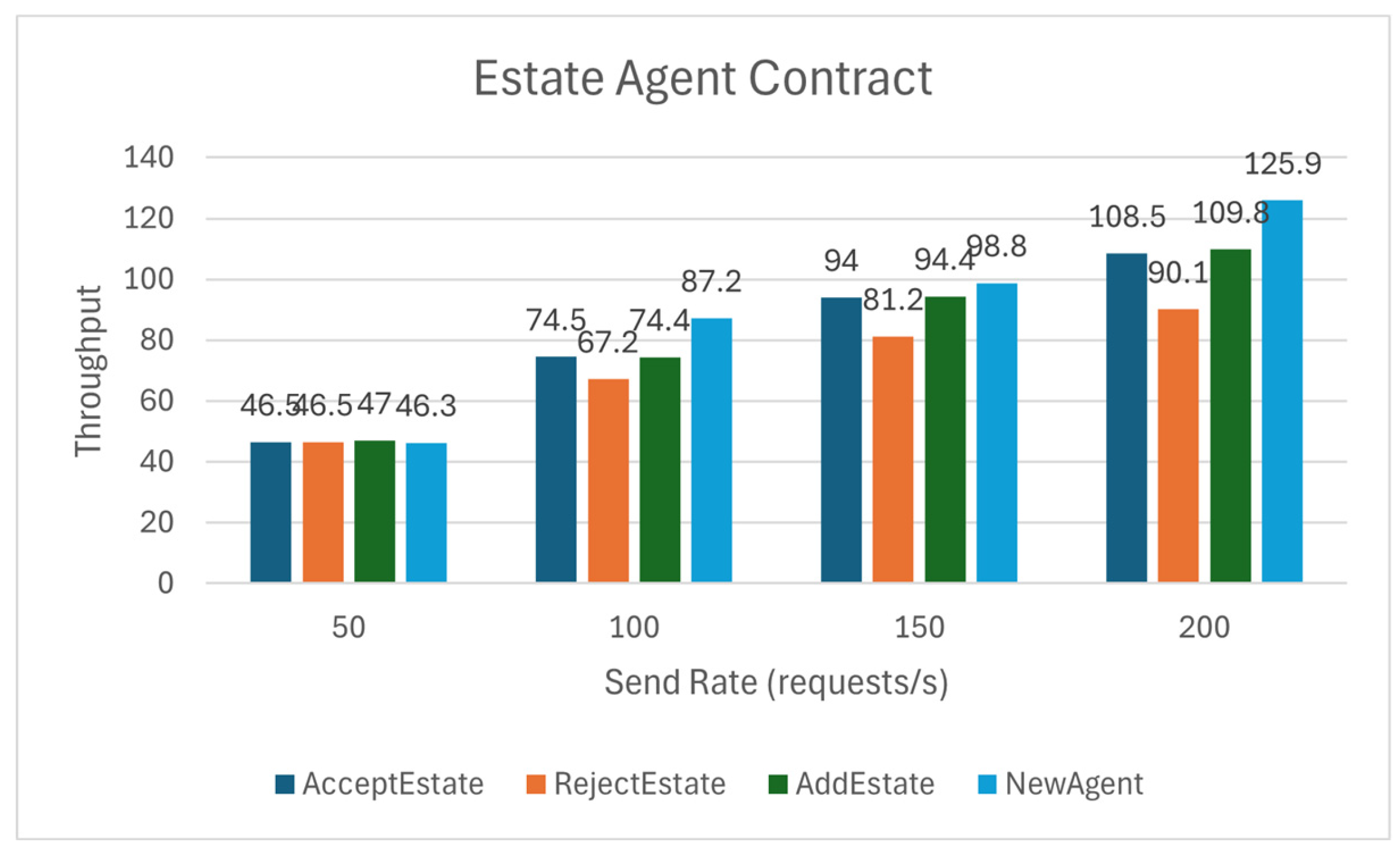

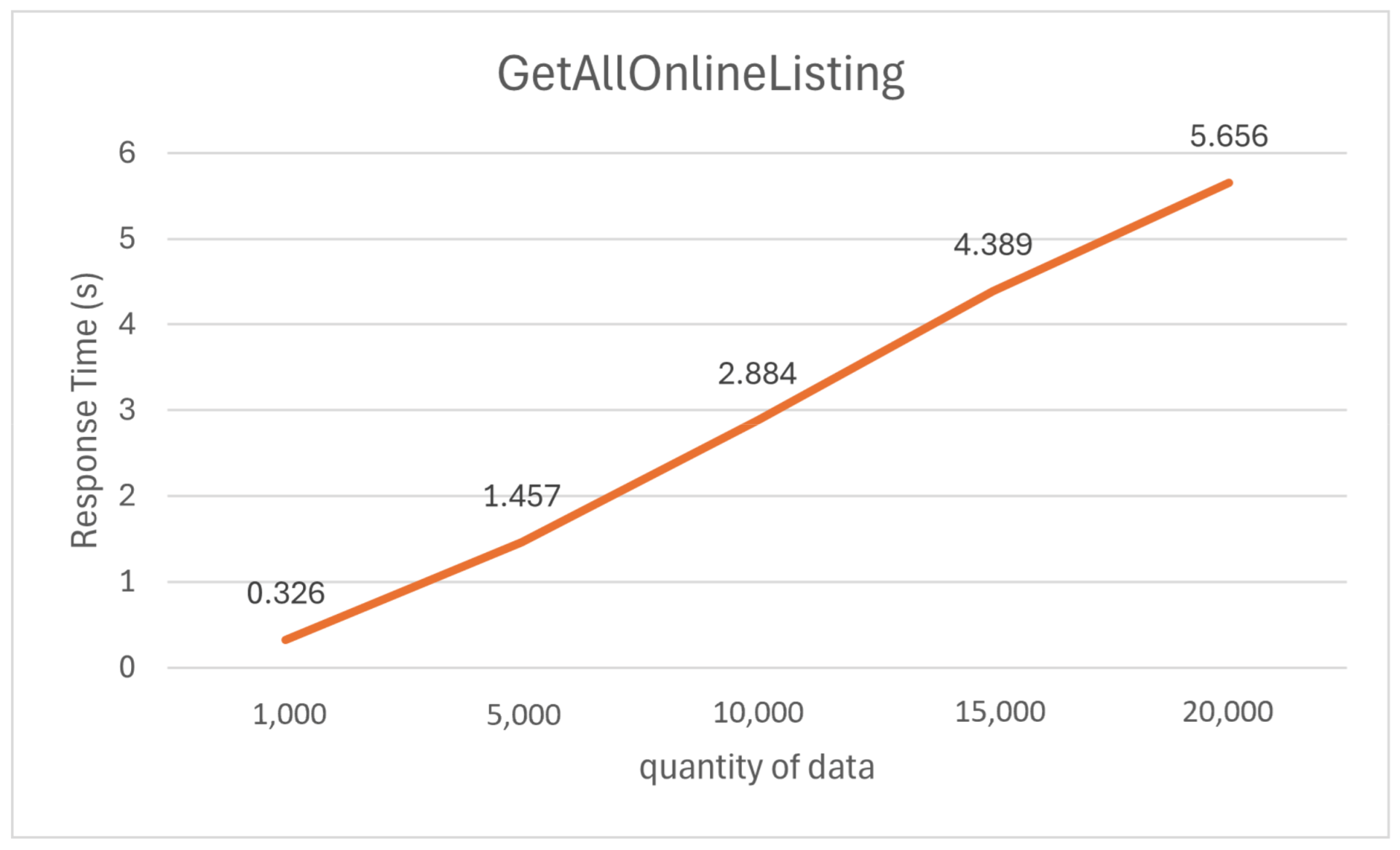

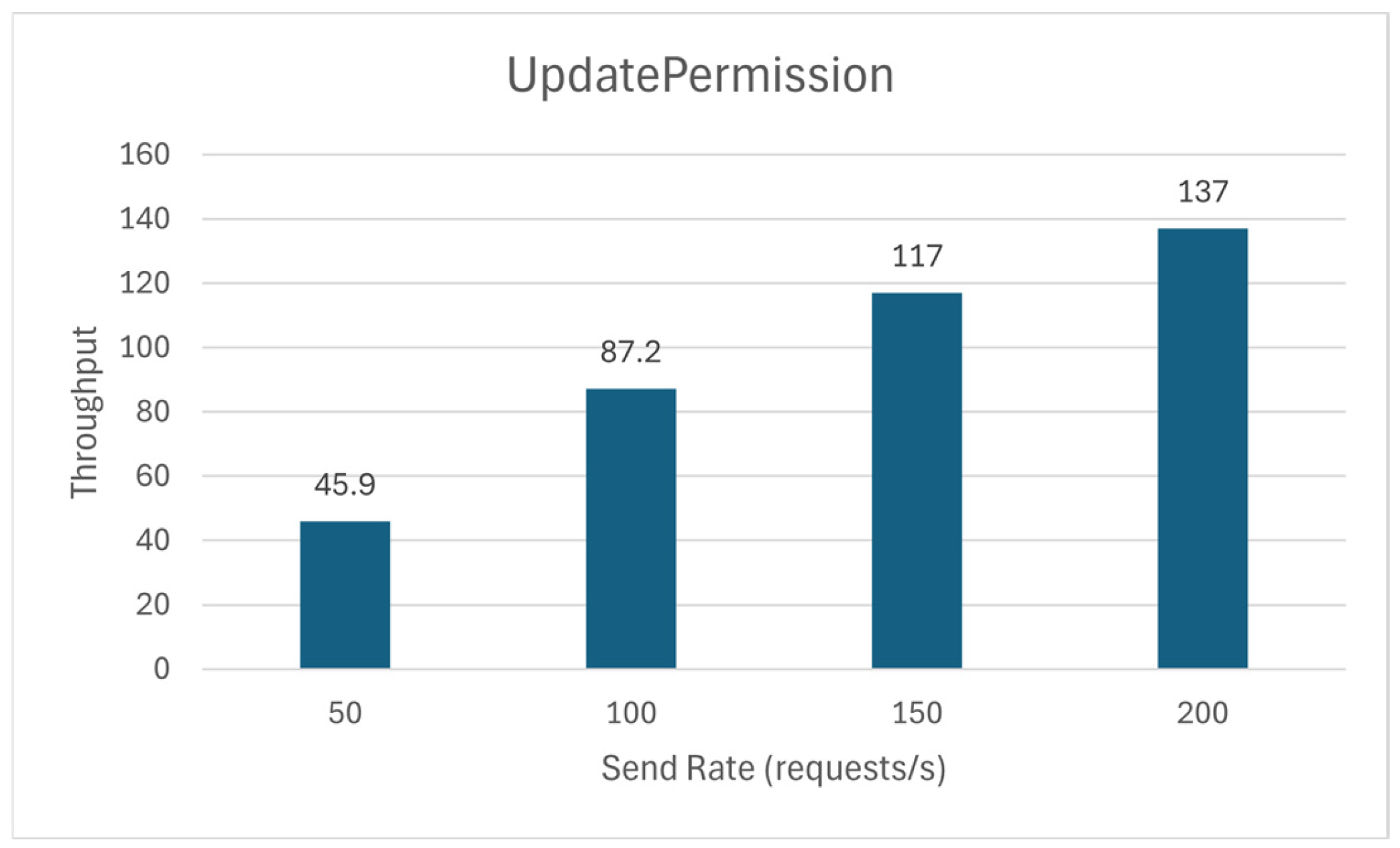



| Variable | Type | Description |
|---|---|---|
| address | string | The address of the estate. |
| area | number | The area of the estate. |
| date | string | The issue date of the land ownership certificate. |
| Variable | Type | Description |
|---|---|---|
| address | string | The public key of the estate agent. |
| expDate | string | The certificate’s expiration date. |
| Variable | Type | Description |
|---|---|---|
| ownerAddress | string | The address of the estate owner. |
| estateAddress | string | The address of the estate. |
| type | string | Records the type of entrustment, whether it is only responsible for renting or includes management after renting out. |
| state | string | Records whether the real estate agent has accepted the entrustment. |
| Variable | Type | Description |
|---|---|---|
| uploader | string | The public key of the estate uploader. The uploader may be a landowner or a real estate agent. |
| estateAddress | string | The address of the estate. |
| owner | string | The address of the estate owner. |
| rent | int | Rent is registered for this property by the landlord. |
| state | string | Records the rental situation. |
| restriction | json | The conditions that the landlord hopes for from the tenant; the restricted item is used as the key, and the corresponding value is used as the value. |
| Variable | Type | Description |
|---|---|---|
| address | string | The address of the lease item. |
| partyA | string | The public key of the landlord. |
| partyB | string | The public key of the tenant. |
| agreementHashed | string | The hashed value of this agreement in the database. |
| Variable | Type | Description |
|---|---|---|
| partyA | string | The signature of the landlord. It can be verified by agreementHashed and the landlord’s public key. |
| partyB | string | The signature of the tenant. It can be verified by agreementHashed and the tenant’s public key. |
| Variable | Type | Description |
|---|---|---|
| type | string | The key to this type of access control data. |
| access | string | The access set by the user. |
| endTime | string | The expiry date of the type of access right. |
| Function | Permitted Roles | Description |
|---|---|---|
| UploadPersonalEstate() | Department of Land Administration (DLA) | Used by the Land Administration Authority (DLA) to upload verified real estate ownership information to the blockchain and securely link it to the owner’s account, addressing the issue of fraudulent property listings at the source. |
| GetEstate() | System Application | To enable the System Application to query real estate ownership information and verify the authenticity of a property using the owner’s public key and the property’s address in order to support subsequent rental processes. |
| Function | Permitted Roles | Description |
|---|---|---|
| NewAgent() | Department of Land Administration (DLA) | The Land Administration Authority (DLA) uploads real estate agent certification data to the blockchain, linking the agent’s public key with their verified credentials to ensure that only authorized agents can participate in transactions. |
| GetEstate() | System Application | Used by the System Application to query agent certification data in order to verify the agent’s identity and credentials. |
| AddEstate() | Property Owner | The property owner initiates a delegation request to a designated certified real estate agent, including the property to be delegated and the type of delegation (rental-only or full delegation). |
| AcceptEstate() | Real Estate Agent | The real estate agent accepts the delegation request from the property owner and is officially granted management authorization. |
| RejectEstate() | Real Estate Agent | The real estate agent rejects the delegation request from the property owner. |
| GetAgentEstate() | Property Owner/ Real Estate Agent (via System Application) | Query detailed information of a specific delegation record based on the agent’s public key and the property address for use by relevant parties. |
| GetAllAgentEstate() | Property Owner/ Real Estate Agent (via System Application) | Query all delegation records associated with a specific real estate agent. |
| Function | Permitted Roles | Description |
|---|---|---|
| NewListing() | Landlord/ Authorized Agent | Allows the landlord or their authorized agent to publish a new rental listing on the blockchain and set its status to “online”. |
| GetAllOnlineListing() | Tenant/ System Application() | Provides tenants with a list of all available rental properties currently marked as “online,” serving as a key read operation in the system. |
| GetListing() | User/Tenant (via System Application) | Allows users to obtain detailed information and lease terms of a specific property using the landlord’s public key and property address. |
| GetListingCondition | User/Tenant (via System Application) | Queries the restrictions and tenant eligibility requirements for a specific property. |
| GetPersonListing() | Landlord/ System Application | Retrieves all property listings associated with a given landlord’s public key. |
| ListingSigned() | Rental Agreement Contract/court | After the lease agreement is signed, the status of the property is updated to remove it from “online” listings, ensuring the timeliness and accuracy of property information on the platform. |
| Function | Permitted Roles | Description |
|---|---|---|
| CreateAgreement() | Court | The court records the encrypted hash value and related metadata of the Rental Agreement on the blockchain, serving as an immutable digital fingerprint of the agreement. |
| SignAgreement() | Landlord/Tenant | The landlord and tenant upload their digital signatures of the agreement’s hash value to the smart contract, confirming mutual agreement on the terms and ensuring the legality and authenticity of the contract. |
| VerifyAgreementSign() | Court/System Application | Verify the authenticity of the landlord’s and tenant’s digital signatures to ensure that they match the original agreement hash value. Upon successful verification, this function triggers the Estate Publish contract to update the property status to “Signed,” marking the agreement as officially effective and recorded on the blockchain. |
| Function | Permitted Roles | Description |
|---|---|---|
| UpdatePermission() | Tenant | Tenants update or assign access permissions to their specific personal data (such as income records or background check results), allowing them full control over data usage and enabling user-centric data governance. |
| GetPermission() | National Tax Bureau (NTB) | Allows third-party organizations (such as the National Tax Bureau, NTB) to retrieve the tenant’s latest permission settings, enabling verification of the tenant’s eligibility (e.g., income) without directly exposing sensitive data, thereby protecting the tenant’s privacy. |
| CPU | Core | RAM |
|---|---|---|
| Intel i5-10400 2.9 GHz (Intel, Santa Clara, CA, USA) | 12 | 16 GB |
| Our Research | Sanskar Sharma et al. [4] | Laila Junaid et al. [7] | João F. Santos et al. [11] | |
|---|---|---|---|---|
| Blockchain | Hyperledger Fabric | Ethereum | Ethereum | Hyperledger Fabric |
| Identity and property authentication | Use DID Chain and DLA authentication | Soulbound Tokens trace identity | A specific Property Identification Number (PID) | Registration with the CA |
| Transparency | Blockchain architecture | Blockchain architecture | Blockchain architecture | Blockchain architecture |
| Lease protection | Contracts and signatures are recorded on the blockchain through the court | Rent control through smart contracts | △ | △ |
| Personal data sharing vulnerabilities | After authorization, verification is performed by a credible third party | X | X | Tenants upload files and authorize sharing |
| Other features | Can entrust real estate agents; private keys are under personal control, DID Chain | Reputation and review | Combined with a blockchain-based mortgage to prevent double-spending | The system generates audit reports |
Disclaimer/Publisher’s Note: The statements, opinions and data contained in all publications are solely those of the individual author(s) and contributor(s) and not of MDPI and/or the editor(s). MDPI and/or the editor(s) disclaim responsibility for any injury to people or property resulting from any ideas, methods, instructions or products referred to in the content. |
© 2025 by the authors. Licensee MDPI, Basel, Switzerland. This article is an open access article distributed under the terms and conditions of the Creative Commons Attribution (CC BY) license (https://creativecommons.org/licenses/by/4.0/).
Share and Cite
Tseng, C.-H.; Hsieh, Y.-H.; Chang, Y.-Y.; Yuan, S.-M. Towards a Trustworthy Rental Market: A Blockchain-Based Housing System Architecture. Electronics 2025, 14, 3121. https://doi.org/10.3390/electronics14153121
Tseng C-H, Hsieh Y-H, Chang Y-Y, Yuan S-M. Towards a Trustworthy Rental Market: A Blockchain-Based Housing System Architecture. Electronics. 2025; 14(15):3121. https://doi.org/10.3390/electronics14153121
Chicago/Turabian StyleTseng, Ching-Hsi, Yu-Heng Hsieh, Yen-Yu Chang, and Shyan-Ming Yuan. 2025. "Towards a Trustworthy Rental Market: A Blockchain-Based Housing System Architecture" Electronics 14, no. 15: 3121. https://doi.org/10.3390/electronics14153121
APA StyleTseng, C.-H., Hsieh, Y.-H., Chang, Y.-Y., & Yuan, S.-M. (2025). Towards a Trustworthy Rental Market: A Blockchain-Based Housing System Architecture. Electronics, 14(15), 3121. https://doi.org/10.3390/electronics14153121






